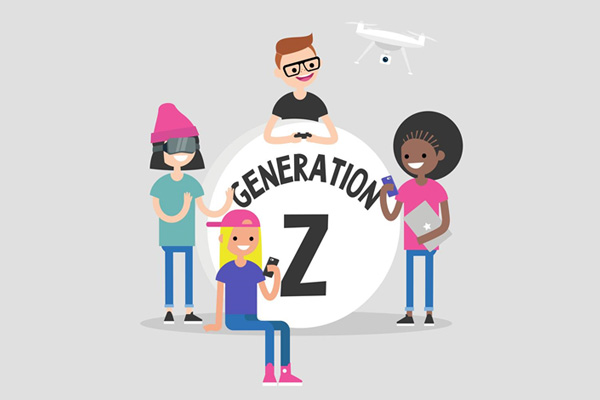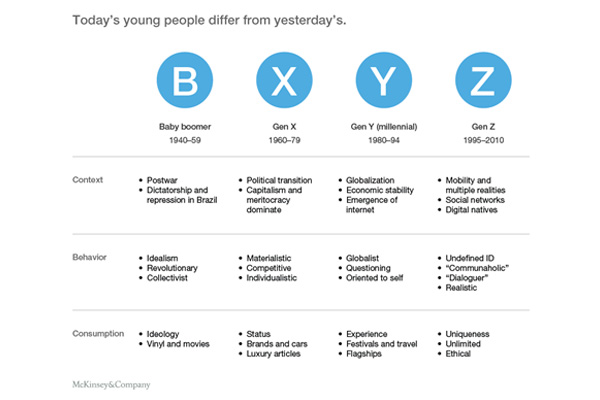Generation Z: The first generation of true digital natives

Setting limits for generational cohorts is an imperfect science, but marketers seem to have settled on an age bracket between 1995 and 2010 for Gen Z, as per one research by Pew Research Center. The oldest members of Gen Z will turn 22 this year, while the youngest will turn 09. Their lives are fast and connected, they are not familiar with words like “BARRIERS & RESTRICTIONS”.
Members of Gen Z are clearly comfortable with making their own decisions rather than leaving these choices up to their parents and guardians like previous generations. The boom in e-commerce and online shopping is a reason this generation is making quick decisions when it comes to buying stuff.

Members of Gen Z are true digital natives: from very young age, they have been exposed to the internet, social networking sites, e-commerce and mobile systems. That milieu has produced a hypercognitive generation who is comfortable with collecting and cross-referencing many sources of information and with integrating virtual and offline experiences.

Why focus on Generation Z:
Generation Z is overtaking millennials by numbers, they comprise 32% of the global population of 7.7 billion in 2019, nudging ahead of millennials, who will account for a 31.5% share, based on Bloomberg analysis of United Nations data, and using 2000/2001 as the generational split. As Generation Z is taking center stage marketers and brands need to change their marketing strategies as well.

4 Essential Strategies for Marketing to Generation Z:
1. Innovation on Digital Channels
No matter what your product is, if you want to attract Generation Z, you need a robust social media presence. Twitter, Instagram, Snapchat, and Facebook are all important social media channels for Generation Z. As a business owner, you must tailor your content to each specific social network. Don’t share the same content on Facebook that you do on Instagram. Generation Z consumers use different social channels for different purposes, and they remember information.
For example: Ufone has a clear-cut strategy for social media networks like Facebook, Instagram and Twitter. Ufone uses Facebook to build a community of customers and engage them with crafted content while the Instagram is used to address consumer queries and answer questions. With well-shot images on Twitter, one can say that Ufone has cracked the code for utilizing social media for different purposes. Ufone is uploading video ads and bundles on Youtube and marketing it directly to Generation Z.
2. Influencers instead of Celebrities
Generation Z is looking for real people on digital media for product reviews and endorsements, instead of relying on celebrities or advertisements, they turn to influencers for input on what to buy. Celebrities tends to be out of reach, and it is impossible to relate with them. Unlike millennials, Gen Z take this thing seriously. Influencers add more effort in creating reliable message for people and Generation Z is digging it.
For example: So Kamal is a fashion retail brand and they are actively engaging influencers and student ambassadors for their marketing campaigns especially on their Instagram platform. In the start on 2019, So Kamal started engaging students from all over the Pakistan and selected student ambassadors. These micro influencers were wearing and endorsing the brand among their peers and social group.
3. Generation Z is Socially Conscious
Generation Z consumers aren’t shy about using their mobile wallets to show their support for businesses that share their values and views. They are aware of the happenings and they are inclined towards the brands focusing on CSR campaigns. Brands that are actively contributing to charities that Generation Z cares about, giving back to the community, being environmentally responsible, or taking a stand on important social issues are all ways to build clout with this generation. However, it’s vital that your socially responsible actions also be authentic. Don’t try to fake it—Generation Z can smell that a mile away.
For example: Telenor started a campaign “Share Your Meal”. Telenor in collaboration with Pakistan Bait-ul-Maal, distributed food supplies worth Rs2.5 million to 1,000 families in Thar. Telenor started this major CSR campaign three years ago by the name of #TweetAMeal through which people were asked to tweet pictures of the meals they have in Ramazan and against the number of tweets that came in, Telenor Pakistan donated a sum of that amount to the people in hunger struck areas. This campaign helped Telenor to tap the soft corner of their Gen z market segment with a huge deeper impact.
4. Generation Z likes to be a part of your Marketing
It is essential to involve Gen Z in your marketing campaigns, if they cannot relate with your message its likely they will not buy your product. Trending successful brands are opting for the campaigns that involves user’s input. Trending hashtags, picture contests, testimonials, etc. are few ways to involve Gen Z in your marketing process.
For example: When it comes to marketing right to the niche, Coca-cola is the king. They know how to engage their audience. The brand used the hashtag campaign, #Shareacoke along with personalized Coca-Cola bottles, to encourage sharing and gifting of Coca-Cola bottles. Additionally, the brand launched a website for its customers to order coke bottles with personalized labels. In result, coke received a nice reaction from its audience.
Previous Article
« Tremors in Ad-world of Pakistan-
AUTHOR

Amina Jamil
Head of Strategy in a Marketing Agency
She is a social activist associated with national and international nonprofit NGOs like World Merit, Merit 360, Postcards for peace, World Turner Syndrome Association and SHE (Female empowerment project)



